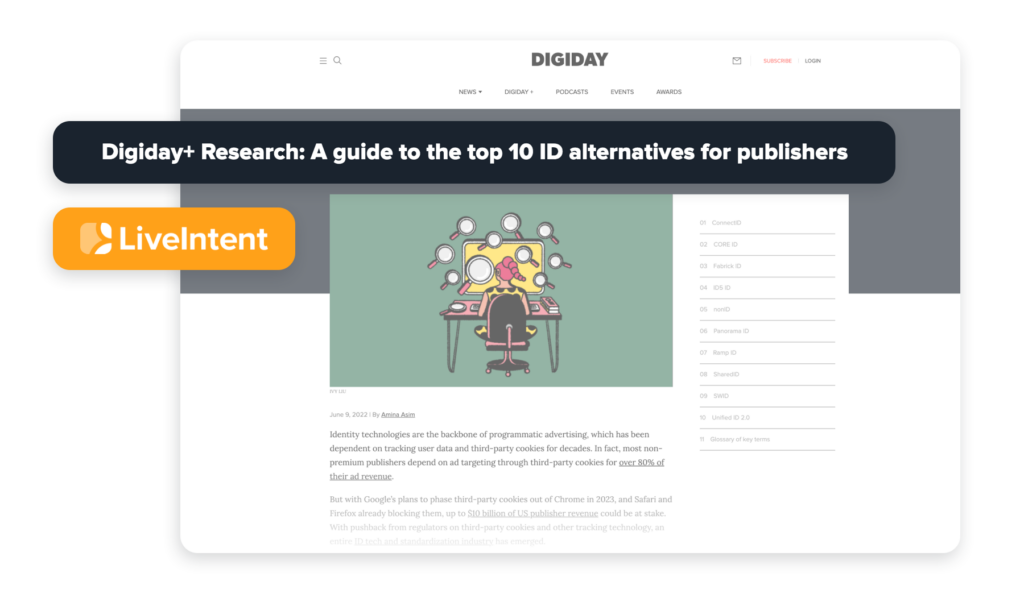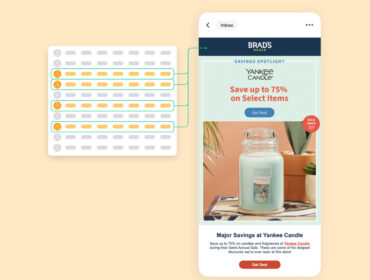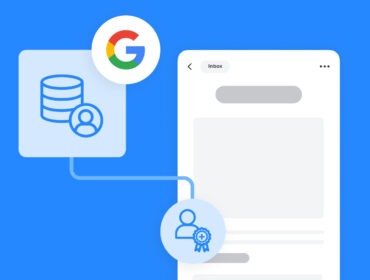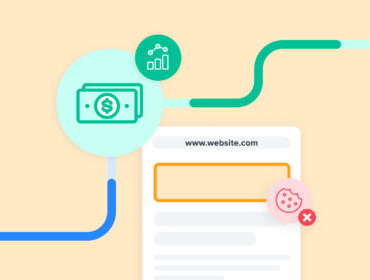LiveIntent’s Identity Framework recognized as top 10 in the industry
LiveIntent was recently named one of Digiday’s top 10 Identity solutions (the article is behind a paywall, but as a publication essential to understanding our industry, Digiday is worth a subscription). Getting here was hard work, and we’re proud to be on this list.

It all begins in email
LiveIntent was the first company to bridge the email channel (first-party) to third-party cookies — the currency relied on to buy and sell inventory. By doing so, we made email inventory addressable to buyers and their DSPs.
We accomplished this by virtue of our position at the intersection of email and ad tech. The combination of ad tech and martech signals provides the least obvious, most powerful way to build a sustainable, organic first-party identity graph capable of bridging first-party cookies to the ecosystem for publishers and brands. It also ensures that it remains private for each client.
Our first-party identity graph bridges an email open to the ecosystem by leveraging third-party cookies to make the impression addressable and valuable to buyers. That same first-party identity graph also represents the bridge from first-party cookies to CRM data — or other IDs publishers, brands, and their vendors need to make inventory addressable and valuable, including any proprietary IDs.
Email isn’t just the workhorse of CRM. It’s also core to other profitable channels like remarketing (in email and social — or anywhere you can upload email hashes like Facebook, Instagram, Twitter, Google AdManager (via publisher provided IDs), Amazon, LinkedIn, Taboola, LiveRamp, Criteo, AdRoll, etc.) and acts as the fulcrum to build lookalike audiences and efficient acquisition strategies. Brands and publishers that embrace email will have the upper hand once the other third-party cookie shoe drops.
Our solution is interoperable and designed to be open
In a cookieless world, ID interoperability is essential for scale. That interoperability becomes particularly crucial as the industry realizes that there will likely not be any one Universal Identifier to replace the third-party cookie. In order to succeed in the space, the ecosystem will need to connect across platforms and bridge efforts.
That is the philosophy behind our Authenticated Bridge framework. Our nonID serves as a bridge identifier that connects to ecosystem identifiers while giving control back to publishers. With our approach, publishers have more flexibility to decide on the Identifier to transact with: whether it be the LiveIntent nonID or other ecosystem identifiers. This is done simply and elegantly by implementing the LiveIntent Javascript tags on publisher pages.
We’re delivering addressability with privacy and consent built-in, and it’s a natural extension of our vision
Our solution delivers an addressability framework powered by email, the original channel built on consent, that respects a user’s preferences. It is engineered with consent and security in mind, it is not reversible, and proven for a world where the third-party cookie is dying. It brings the addressability of logged-in environments like the walled gardens and the email channel to the open web.
We believe our clients should have control
By providing a path back to the hashed email address, our clients decide how to leverage our solution. We are providing more data so that customers can understand connections and accuracy on their own, with their own models, without being tied to our definition of truth.
The solution is simple and puts the publisher in control. Publishers are given the privilege of consent by the nature of their relationship with their readers; our solution extends that consent to wherever the readers are present and paying attention, to the exclusive benefit of publishers.
We built it with simplicity in mind. It is easy to adopt, can be tuned for each use case, and connects to existing proprietary Identity solutions.
This is just the beginning
Email was the first channel to go cross-device (you checked the same email on your desktop as on your Blackberry). That’s why LiveIntent has such deep chops in navigating a world built around Identity. As the industry begins its long march toward deprecating third-party cookies, LiveIntent has a head start. Unlike many entrants into the Identity market, LiveIntent’s approach is not a workaround. Email is already a trusted channel for customer relationship management and marketing automation, which are the heart of marketing. Thousands of publishers already rely on LiveIntent to monetize their first-party email inventory; LiveIntent is seamlessly bringing that expertise to first-party inventory beyond email (native, mobile, web, apps, video, etc).
The use cases for our solution are endless for those seeking Identity solutions but all are built to address the same problem: help publishers and brands in an era where the cookie is going away and all their inventory will be first-party. We have built a technology to bridge a brand’s first-party inventory to the ecosystem with the controls to allow a consumer to opt out anytime, aligning the solution with CCPA. This keeps brands and publishers in control and lets them control their destiny in an era where the walled gardens continue to create ever more hostile terrain for them. Our nonID is crucial for brands in a first-party world looking to perform: identity resolution, consent management, audience targeting, attribution, measurement, personalization, marketing automation, analytics, and recommendations, allowing advertisers and DSPs to transact on a stable identifier for targeting People-Based Audiences across their inventory, and so much more. We empower this by enabling data to flow to publishers and brands, not away from them.
Thanks to Digiday for recognizing our work. We’re excited about the next phase in our industry and helping our clients control their destinies. To learn how we can help your business in the next era, contact us here.


